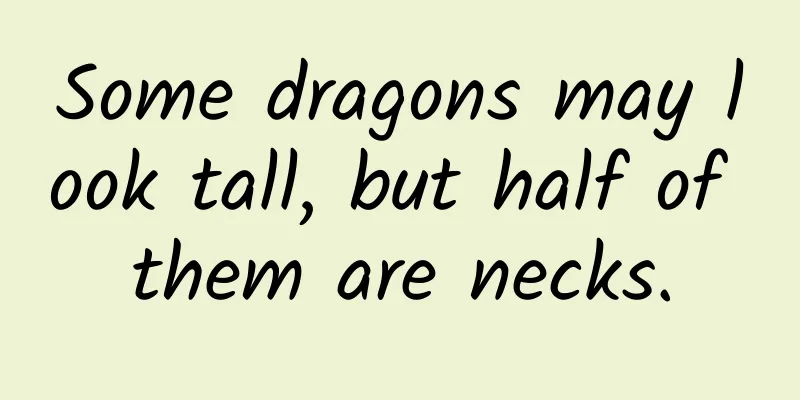Some dragons may look tall, but half of them are necks.

|
The Jurassic and Cretaceous periods of the Mesozoic Era can be said to be the "Age of Dragons". Dinosaurs ruled the land, pterosaurs ruled the sky, and in the vast ocean, several major forces competed with each other. Among them, the three most "powerful" groups were the ichthyosaurs that were the first to go to the sea, the mosasaurs that joined the dispute last, and another most distinctive group: the plesiosaurs. When talking about plesiosaurs, many people will think of this appearance: a small head on a long neck, and four paddle-like flippers on a fat body. Nobita's pet in "Doraemon" is a plesiosaur (Futabasaurus suzukii). But in the plesiosaur group, there are also pliosaurs with short necks and big mouths. And our protagonist today is the member with the longest neck in the plesiosaur family Elasmosaurus: Elasmosaurus platyurus. Model of the Elasmosaurus, located at the University of Alberta's centennial centre for interdisciplinary science | IQRemix / Flickr The neck is above the feet When talking about animals with long necks, most people's first impression is giraffes, and many people will think of turtles. Indeed, their necks are quite long, but they are nothing compared to the neck of the Scaphodon. How long was the neck of the Scaphodon? When we describe long legs, we say: "The legs are below the neck", so the neck of the Scaphodon may be: "The neck is above the feet". Indeed, half of the length of this guy's body is contributed by the neck, and there are more than 70 cervical vertebrae alone! Friends may ask: "What is such a long neck used for?" This question also puzzles paleontologists. In the early years, people thought that the neck of the elasmosaurus must be very flexible. Although the giraffe's neck is long, it only has seven cervical vertebrae, while the swan's cervical vertebrae have 25 cervical vertebrae. The swan's neck is much softer and more flexible than the giraffe's. The number of cervical vertebrae of the elasmosaurus is more than three times that of the swan, so it must be more flexible and soft! Early reconstructions of Clidastes and Mosasaurus, with very curvaceous shapes | Biodiversity Heritage Library Some people imagine that the lamellaeosaurus could stretch its neck into the reef cave like an eel to catch various small animals, or rush out of the water to bite low-flying pterosaurs, or hide its body in the sand on the seabed, waiting for prey to approach and suddenly stick its head out, or float on the water to attack the fish swimming below... It's still very exciting to think about this picture. Some museums also assembled the skeletal specimens of the lamellaeosaurus into a large-scale curved shape based on this idea. However, in recent years, through further restoration and research on the muscles attached to the cervical vertebrae of the lamellaeosaurus, it was found that this long neck is difficult to make a large range of curling or lifting movements, and is not as soft and dexterous as a snake. Reconstruction of the Scutellaria | DiBgd / Wikimedia Commons Based on this premise, paleontologists speculate that the Sphenodon would swim slowly across the seabed while swinging its long neck from side to side and poking its small head into the sand of the seabed to look for food, or it would stick its small head directly into a school of fish with its long neck. In this way, the fish would not be able to see its huge body and would have the illusion that "this creature is not big and will not be dangerous." When the fish are paralyzed and careless, the Sphenodon would bite through the fish's body with its long and sharp teeth at lightning speed. Zarafasaura oceanis, also a member of the family of elasmosaurids | Ghedoghedo / Wikimedia Commons Fossil Wars Most aquatic vertebrates choose their tails as their locomotion organs, with the propeller located at the rear of the central axis. This layout can produce the strongest propulsion with the least energy consumption. For example, fish, ichthyosaurs, and mosasaurs swing their tails left and right, while whales and dolphins flap their tails up and down. The lamelliosaurs mainly rely on the paddle-shaped flippers evolved from their limbs to provide power, and in the recently discovered plesiosaur fossils, diamond-shaped horizontal tail fins were found, so it is speculated that its tail may also move up and down as an auxiliary power source. Model of Elasmosaurus, Taipei, China | Gary Todd / Flickr The Scaphosaurus is well-known in the paleontological community, not only because of its unique appearance, but also because it was the fuse of the "Bone Wars". This incident dates back nearly 150 years ago, when there were two famous paleontologists in the United States, Othniel Charles Marsh and Edward Drinker Cope. Cope discovered the fossils of the Scaphosaurus and restored and assembled them, but he mistakenly installed the cervical vertebrae on the tail. As early as 1870, Cope's teacher Joseph Leidy had pointed this out. In 1890, Marsh published Cope's mistake in a publication and ridiculed this low-level mistake, which made Cope lose face and caused the two to become enemies. Cope's drawing of the lamellaeosaurus vertebrae | Biodiversity Heritage Library The conflict between the two became more and more intense, and finally turned into a competition, scrambling to prove that they were more amazing than each other. A "war" to discover more fossils and more new species of ancient creatures began. It was not until Cope's death in 1897 that this war, which lasted for more than 30 years, came to an end. During this period, nearly 150 dinosaur species were named. However, the radish was too fast to clean up the mud, and later generations found that most of these names were incorrect classifications or repeated names of the same fossil. Why did the lamellipodosaur have such a long neck? How did it use this long neck to catch food? How did it swim with its flippers? Perhaps the truth is hard to find, but the most precious legacy left to us by this long-necked dragon is to allow every child who loves ancient animals to have endless reverie. |
<<: Species Exploration: What are those strange creatures in "Longling Mystery Cave"?
>>: Can children use facial cleansers? A review of 13 popular children's facial cleansers
Recommend
It’s not wrong to want to “lie down”, the “lazy cancer gene” is innate!
Reviewer: Ji Shi Life Field Observer A quarter of...
Video UGC breakthrough: Video-based self-media
The domestic video UGC model looks more and more ...
Summary of Xiaohongshu’s operation and promotion methods!
Traffic exposure 1. The traffic for the note I po...
Why does "Hua Xizi" combine "online + offline" marketing?
" Hua Xizi " was born in Hangzhou, Chin...
3 drainage principles to help you attract new customers efficiently
User growth is almost the ultimate proposition of...
Who can put an end to the prestige of the “4G Overlord Package”?
According to the China Consumers Association, it ...
It is worth pondering whether OLED 4K TV should avoid following the old path of plasma TV in its development
So far, judging from the semi-annual reports rele...
The Avita 11 Hongmeng cockpit has been updated for the entire series. What are the differences after the upgrade?
In one month, the Hongmeng version of Avita 11 wa...
4 tips and 6 taboos for live streaming sales
As a short video platform with more than 600 mill...
A complete analysis of user retention strategies!
After the user is activated, we need to find a wa...
How to use the five major features of QQ promotion to carry out online marketing?
Many marketing and promotion personnel will use Q...
How to take beautiful airplane window photos when traveling?
Where did you travel in the Year of the Dragon? B...
Xpeng Motors Financial Report: In Q1 2022, Xpeng Motors' net loss was 1.7 billion, an increase of nearly 1 billion yuan year-on-year
Recently, Xpeng Motors announced its unaudited fi...
Listen to the advice! When the "H1N1" strikes, how should we take medicine and how can we prevent it?
Recently, influenza outbreaks have occurred in ma...









